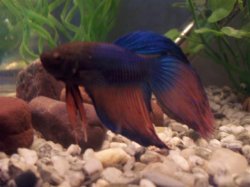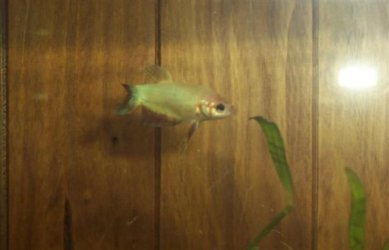You are using an out of date browser. It may not display this or other websites correctly.
You should upgrade or use an alternative browser.
You should upgrade or use an alternative browser.
Tarzeik
- Thread starter FisheyAsh
- Start date
Bubblenester
Fish Crazy
You've got yourself a beautiful "mustard gas". It's a popular color and is often abbreviated MG. One of my personal favorites. 

ibbledibble
Fish Addict
i thought mustard gas was when the fins were yellow? hence "mustard"?
TribeOfShroom
Fishaholic
i thought mustard gas was when the fins were yellow? hence "mustard"?
I don't know much about colouration names etc, but I was under the same impression that mustard was yellowish-green
The original Mustard gas bettas had a solid blue/greenish body and yellow fins....
nowadays, the term mustard gas is a very plastic term. The pattern of the colors of the different MGs differs from fish to fish. Some fishes also have blue/green/black edges around their fins while others lack these features. Most of the "modern" Mustard don't even come close to the original Mustard gas colourings!
Code:
[b][i]http://vanriel.myadsl.nl/BT-AABcolorgenetics.htm[/i][/b]hope that clears thigs up
xxx Chrissy
so its a modern Mustard gas i guess!
ibbledibble
Fish Addict
Well actually its definitely not a mustard gas, as that is a trademarked term for a specific line of fish from a single breeder
i think he would actually be described as a dark bicolourWhat is a Mustard Gas?
By: Victoria Parnell
Submitted: 3/31/2006
These days, the term Mustard Gas (or "MG") is used, incorrectly as it happens, to describe any bicolored fish that possesses a green, blue, or steel blue body and yellow or orange fins. This particular color combination has, in fact, been in existence about as long as the Non Red gene itself, since it is fairly easy to breed an iridescent betta to a Non Red betta and get iridescent/yellow bicolors by the 2nd generation.
The "Original" Mustard Gas
The term "Mustard Gas" was originally coined by breeder/hobbyist Jude Als to describe his particular line of multicolored bettas. The original Mustard Gas bettas were green-bodied fish with variegated bands of blue or green, yellow, and black. In 1999, Als added a band of white as well, developing certain specimens of Mustard Gas into a four-banded butterfly, the colors of which were never clearly separated, but rather run together, creating an effect that looked like gas to its creator.
In the late 90's, Als sold some of his Mustard Gas fish to other breeders, some of whom outcrossed the line, but retained the strain name. Therefore, the modern Mustard Gas fish is, today, so far removed from Als' original vision as to be a completely different color/pattern combination.
One of the most intriguing aspect of the Mustard Gas strain name was the controversy it caused among breeders and hobbyists all over the world who were able to acquire fish from Als' strain and, once having spawned them, were at a loss for what to call them. Als was very protective of his Mustard Gas name, and felt that once the pure line was outcrossed in any way, the resulting fish could no longer be called "Mustard Gas". He rallied hard to get others to stop using his strain name, even to the point of securing a trademark for the name in 2002. The primary focus of his campaign was Marianne Lewis, to whom he had given 1 pure Mustard Gas fish, a male. Lewis bred that male to several female fish in her fishroom from different lines, and many fish came of a result of those matings that looked, to her eyes, identical to the Mustard Gas fish she obtained from Als. She bred and sold these "Mustard Gas" fish until Als asked her to quit, at which point she changed the name to "Salamander". This added to the confusion, since people started equating Mustard Gas outcrosses with Salamander, and any red bicolor fish they bred that came from a yellow bicolor outcross was named "Salamander". (It should be noted, however, that Lewis' Salamanders are actually yellow bicolors that resemble the Mustard Gas, and since the creator of the term (Lewis) does not even use the strain name anymore, all those "Salamanders" you see out there are probably as fake as the "MG's".)
The original US Trademark of the Mustard Gas strain name was filed like this:
Word Mark MUSTARD GAS
Goods and Services IC 031. US 001 046. G & S: live tropical fish, namely, betta splendens. FIRST USE: 19991001. FIRST USE IN COMMERCE: 20000811
Mark Drawing Code (5) WORDS, LETTERS, AND/OR NUMBERS IN STYLIZED FORM
Serial Number 76390593
Filing Date April 1, 2002
Current Filing Basis 1A
Original Filing Basis 1A
Published for Opposition December 17, 2002
Registration Number 2695343
Registration Date March 11, 2003
Owner (REGISTRANT) Als, Jude DBA Uncle Junkin INDIVIDUAL UNITED STATES 2838 Sacramento Street Berkeley CALIFORNIA 94702
Attorney of Record DAVID D. STEIN
Type of Mark TRADEMARK
Register PRINCIPAL
Live/Dead Indicator LIVE
As can be clearly seen from the sheer numbers of sellers offering "Mustard Gas" fish for sale, even into 2006, it's obvious that the use of the Trademarked name has completely spiraled out of control. If the above trademark is still in effect, anyone making a profit selling fish as "Mustard Gas" are in clear trademark violation.
D1 - Dark Bicolor
By: Victoria Parnell
Submitted: 12/10/2004
Dark Bicolor bettas are fish that have body colors that are among the six recognized Dark Colors. The fins can be one of the other Dark colors, or it can be one of the recognized light colors. If these fish do not have the described dark undercoating, they are disqualified.
Contrast is key, with the body and fin colors clearly separated at the junction between body and fin. There should be no other colors present other than the two primary Bicolors. The presense of another color, however slight, is considered a fault. For example, a red body with heavy iridescence is judged in accordance with the Standard for Reds. If the fins are black, they are scored presented in the Black color standard, meaning that if the black on the fins of a Bicolor betta has iridescence on it, it will be faulted to the degree of which it is inadequate.
Bubblenester
Fish Crazy
He falls pretty loosely into the mustard gas category, but then again it is used pretty loosely these days. And it's most definitely not just used for Jude Als' original line of fish, as it should be- poor guy! As the article states, the name has really caught on and is now widely used to describe any fish with a green body (or even blue or steel, I sometimes see these listed as "blue gas" or "purple gas") and yellow fins. Of course, dark bicolor would be the more correct term for these fish, I'm just saying that mustard gas would be the term more commonly used, especially by more casual hobbyists who have never even heard of Jude Als.
Whatever you want to call him, he's very pretty!
Whatever you want to call him, he's very pretty!
HODDY
Fish Herder
yes everything stated above is correct.He is a mg.There are quite a few types of mg but the first ever mustard ga was green and yellow.More common now are blue and yellow.Seen loads in lfs recently.
yes everything stated above is correct.He is a mg.There are quite a few types of mg but the first ever mustard ga was green and yellow.More common now are blue and yellow.Seen loads in lfs recently.
yes everything stated above is correct.He is a mg.There are quite a few types of mg but the first ever mustard ga was green and yellow.More common now are blue and yellow.Seen loads in lfs recently.
E3ramirez
Fish Fanatic
wow  georgeous fish. love the colors. Kinda looks like fire lol. Blue flame on top and reddish on the bottom
georgeous fish. love the colors. Kinda looks like fire lol. Blue flame on top and reddish on the bottom 
 georgeous fish. love the colors. Kinda looks like fire lol. Blue flame on top and reddish on the bottom
georgeous fish. love the colors. Kinda looks like fire lol. Blue flame on top and reddish on the bottom 


 i want it fishy!
i want it fishy!